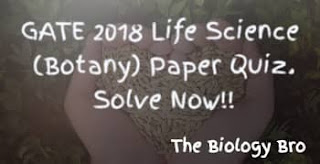1.
Which of the following genera produces dimorphic seeds that help to broaden the time of germination in a variable habitat?
2.
The genes for microRNA (miRNA) in plants are usually transcribed by
3.
Which of the statements is TRUE for transposable elements Ac and Ds?
4.
Identify the CORRECT statement.
5.
Which of the following statements is TRUE for an ecotone?
6.
Acid rain with a pH of 4.0 is more acidic than the rain with a pH of 6.0 by
7.
Which of the following plants produces Ylang-ylang oil?
8.
Identify the INCORRECT statement in connection with polar transport of auxin.
9.
Which of the following stains is used to visualize callose under the microscope?
1 out of 2
11.
Statements given below are either TRUE (T) or FALSE (F). Select the CORRECT combination.
P. Mitosis occurs exclusively in diploid mother cell
Q. Mitosis occurs both in diploid and haploid mother cells
R. Meiosis occurs exclusively in diploid mother cell
S. Meiosis occurs both in diploid and haploid mother cells
12.
You are asked to design a genetic construct for high-level expression of a gene encoding the therapeutic protein 18 (TP18) via plastid transformation. Select the CORRECT set of genetic elements for this construct.
13.
Select the CORRECT combination of the following statements.
P. The cyclic electron transport chain involving PSI results in net production of both ATP
and NADPH
Q. The cyclic electron transport chain involving PSI results in net production of ATP
R. Rubisco enzyme usually converts RuBP and CO2 into 2-phosphoglycolate and
3-phosphoglycerate
S. Rubisco enzyme usually converts RuBP and O2 into 2-phosphoglycolate and
3-phosphoglycerate
14.
Match the fruit characters with their families and representative plant species.
Fruit character....................Family..............Plant species
P. Syconus......................1. Moraceae.......i. Canavalia ensiformis
Q. Capsule, opening by..2. Fabaceae.......ii. Artabotrys odoratissimus
apical pores or valves
R. Legume...................3. Papaveraceae..iii. Ficus religiosa
S. An etaerio of drupe..4. Annonaceae.....iv. Papaver somniferum
.................................................................v. Pistacia vera
.................................................................vi. Citrus aurantium
15.
Select the CORRECT combination by matching the disease, affected plant and the causal organism.
Disease.............Affected plant..............Causal organism
P. Black rot........1. Corn.............i. Fusarium oxysporum f.sp. cubense
Q. Loose smut....2. Banana........ii. Acidovorax avenae subsp. citrulli
R. Panama wilt...3. Watermelon..iii. Botryosphaeria obtusa
S. Bacterial fruit..4. Apple...........iv. Ustilago maydis
blotch
...................................................v. Plasmopara viticola
...................................................vi. Venturia inaequalis
16.
Select the CORRECT combination by matching Group-I with Group-II.
Group-I................................Group-II
P. Photorespiration..............1. Glutamate → 2-Oxglutarate
Q. Respiration.....................2. Acetyl-CoA → Malonyl-CoA
R. Amino acid degradation..3. 2-Oxglutarate → Succinyl-CoA
S. Fatty acid synthesis........4. Glycine → Serine
17.
Match the plant alkaloids with their uses and source species.
Alkaloid....................Use...................Source species
P. Codeine.........1. Stimulant..........i. Hyoscyamus niger
Q. Caffeine.........2. Analgesic.........ii. Catharanthus roseus
R. Scopolamine..3. Antineoplastic...iii. Cola nitida
S. Vinblastine.....4. Anticholinergic..iv. Papaver somniferum
......................................................v. Coptis japonica
......................................................vi. Senecio jacobaea
18.
Identify the CORRECT combination of statements with respect to chemical defense in plants.
P. Pisatin, a phytoalexin produced by Ricinus communis is a constitutive defense compound
Q. Phaseolus vulgaris produces Phaseolus agglutinin I, which is toxic to the cowpea weevil
R. A single step non-enzymatic hydrolysis of cyanogenic glycoside releases the toxic
hydrocyanic acid (HCN) to protect plant against herbivores and pathogens
S. Avenacin, a triterpenoid saponin from oat prevents infection by Gaeumannomyces
graminis, a major pathogen of cereal roots
2 out of 2

